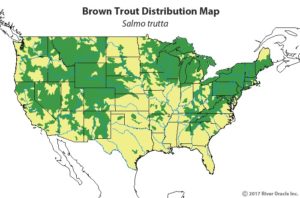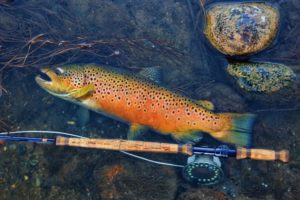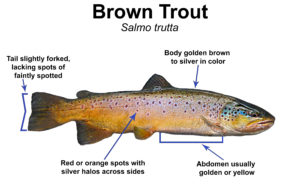The following content is part of our Fly of the Month Club. This article is written by Peter Stitcher from Ascent Fly Fishing.

What is fly fishing if not a childlike game of war? We maneuver and position, count off our successful campaigns in the notches scratched into the cork of our rod, and then each return to our respective homes in time for dinner. Like in war however, the one who claims victory at the end of the day is the one who knows their opponent best. In Sun Tzu’s 5th century tome of military strategy, the Art of War, he repeatedly states the importance of knowing your opponent, understanding their motivations, where they take refuge, how to lure them from cover, and how to turn their arrogance and strength against them. The Trout Smart Series is the angler’s guide into the mind of the trout. Species by species, we will break down the intricacies of brown, brook, rainbow, and cutthroat trout, allowing you to successfully battle with each in turn, until you will need to replace the cork on your rods for all the victory notches that have been added.
Identifying Characteristics:
Perfectly camouflaged for the shadowy depths and algae-covered river bottoms where they lurk, the back and sides of the brown trout vary in color from golden brown to dark silver. The abdomen of this species is a light gold to yellow, while the flanks of the fish are spotted with red to orange dots surrounded by light silver halos. The tail of the brown is slightly forked and is either void of spotting or faintly spotted.
Range & Habitat:


Native to Europe, Central Asia, Scandinavia, and Northern Africa, the Brown trout (Salmo trutta) was first introduced to the United States in 1884 when it was stocked in the Baldwin River in Michigan. The popularity of the brown as a sporting fish saw it quickly spread across the US with reproducing or stocking supplemented populations being found in all but three states. Among the trout and salmon species found in the US, brown trout are among the most reclusive. Preferring the deep and most sheltered sections of the river, brown trout can typically be found in the head to middle sections of pools, deep undercut banks, or tucked in close to large cover such as boulders, tree snags and root wads. It is from these points of relative safety and seclusion that the brown trout spend the daytime hours, allowing them to rocket from cover to take a piece of food before retreating back to their haunts. As the sun sinks in the evening, the trout will rise in the water column, cruising the shallows in search of larger prey through the night.
Feeding Behavior & Foods:
Cue the JAWS soundtrack when you decide to chase brown trout on the fly. These alpha predators employ guerrilla-war-like tactics, ambushing their prey and then retreating into cover. When threatened or hooked, brown trout will dive deep, darting into the current or cover in the attempt to entangle or break off the offending hook and line. The diet of brown trout is largely made up of aquatic invertebrates through the first 2 years of their life, while terrestrials begin to make up a sizable portion of their diet in their 3rd year. It is also in the 3rd year, when the brown trout reaches 12-14 inches in length, that large prey species such as minnows, baitfish, crayfish, and young trout come onto the menu. The larger and older the brown trout get, the stronger their preference for these high calorie, large prey species grows.
Vulnerabilities:
- Knock on their door – Brown trout are easily tempted by big meals presented close to their chosen piece of cover. A large grasshopper pattern dropped close to an undercut bank, or a heavily weighted stonefly nymph dragged through the depths of a pool will often be too tempting a prospect for the brown to let pass by. Getting a good drift where the browns won’t have to chase the food is of paramount importance. Brown trout can be overconfident when close to home, and that sense of security can become their undoing.
- Night Ops – As the sun sinks, the big browns leave their cover and go on the prowl for large prey. Fishing large profile nymphs, streamers, and even dry mouse patterns through the night will give you access to the biggest browns in the river!
- Dumbstruck Love – When water temperatures drop between 44 – 48°F each fall, the brown trout prepare to spawn and become careless. Like frat boys in the bar at last call, browns looking for love become aggressive, reactionary, and will snap at streamers and annoying attractor patterns that encroach in their space. While we NEVER target trout that are actively spawning or sitting on their redds, egg patterns, attractor nymphs, mouse patterns, and streamers can all produce explosive strikes and tons of fish in the net.


